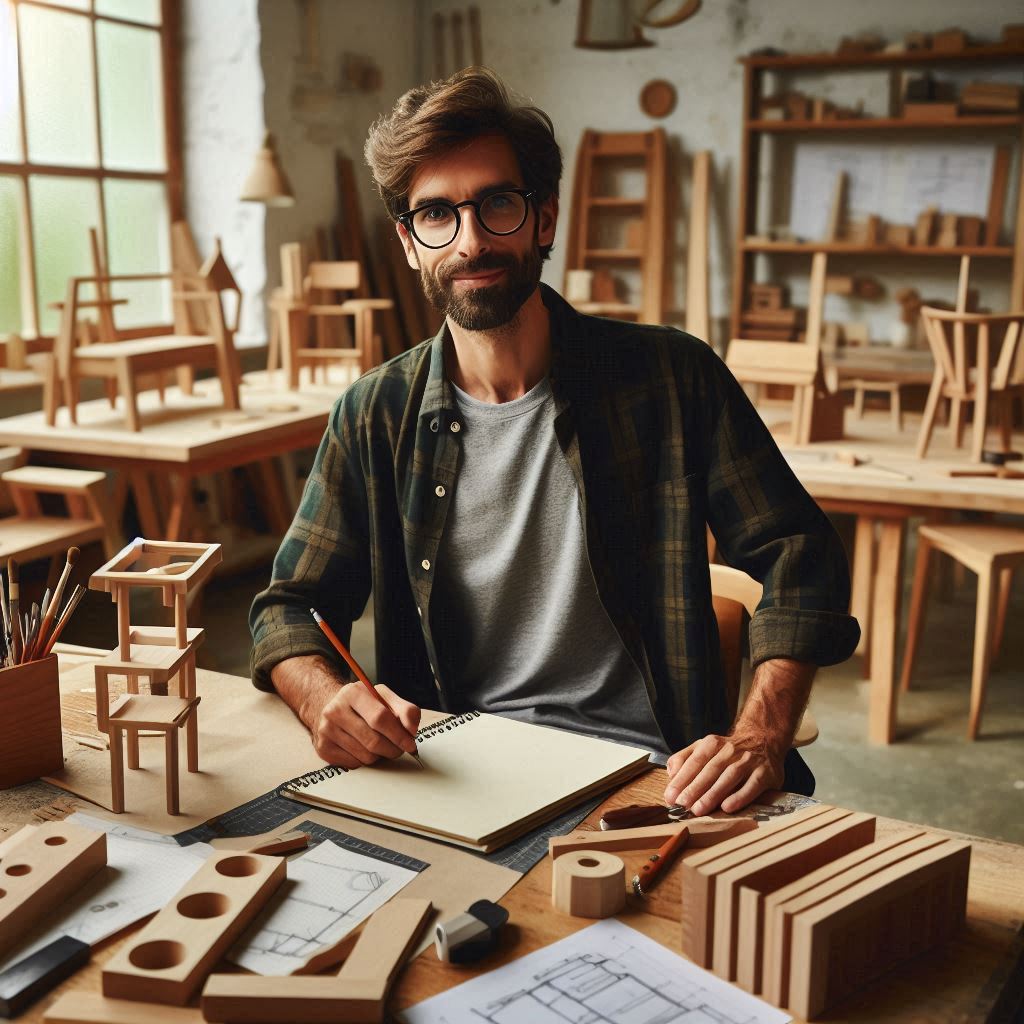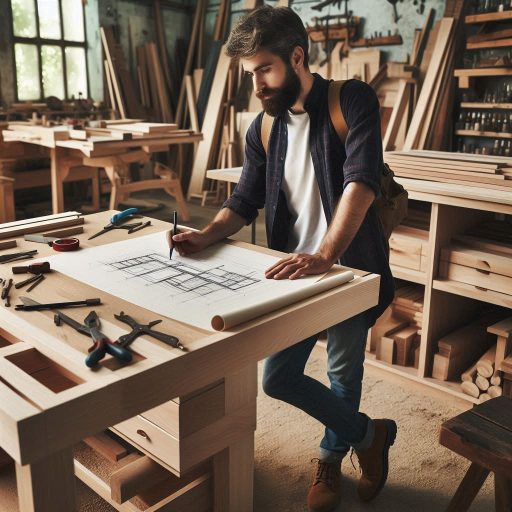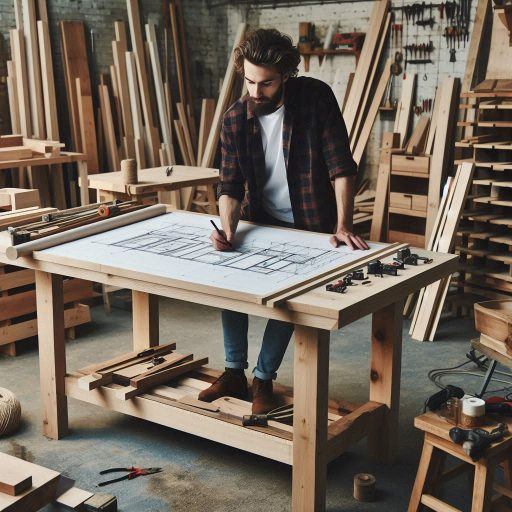Introduction
Staying inspired as a furniture designer is crucial for maintaining creativity and innovation in your work.
Inspiration fuels the design process and leads to unique concepts that capture attention.
Without a steady source of inspiration, designers may struggle to develop fresh ideas or solutions.
Inspiration can come from various sources, such as nature, art, architecture, and even everyday life.
Engaging with different environments and experiences helps spark new ideas and perspectives.
Moreover, inspiration plays a vital role in overcoming creative blocks.
When designers feel stuck or uninspired, exploring new influences can reinvigorate their motivation.
Seeking out art galleries, visiting design shows, or attending workshops can introduce new concepts and techniques that inspire innovation.
Interacting with fellow designers or creative communities can also provide valuable insights and encouragement.
By actively seeking inspiration, furniture designers can enhance their creativity and problem-solving skills.
This approach not only enriches their designs but also keeps their work relevant in a competitive market.
Ultimately, staying inspired is essential for achieving artistic growth and producing exceptional furniture designs that resonate with audiences.
Embracing inspiration leads to a fulfilling and successful design journey.
Surround yourself with inspiration
Staying inspired as a furniture designer is crucial for creativity and innovation.
One effective way to spark your imagination is by creating a mood board or inspiration wall in your workspace.
Create a Mood Board or Inspiration Wall in Your Workspace
This visual representation of ideas can include colors, textures, materials, and images that resonate with you.
By displaying these elements prominently, you keep your creative vision in focus.
Regularly update your mood board to reflect new ideas and trends that inspire you.
This practice fosters a dynamic creative environment.
Visit Art Galleries, Design Exhibitions, and Furniture Showrooms
Visiting art galleries, design exhibitions, and furniture showrooms also serves as a great source of inspiration.
These venues showcase diverse styles and innovative designs that can stimulate your creativity.
Take the time to explore different exhibits and observe how various designers approach their work.
Pay attention to the details, such as form, color, and texture.
Engaging with different artistic expressions can broaden your perspective and enhance your design vocabulary.
Follow Other Furniture Designers and Artists on Social Media for Inspiration
Moreover, following other furniture designers and artists on social media can provide ongoing inspiration.
Platforms like Instagram, Pinterest, and Behance are treasure troves of creative content.
Discover new designers, trends, and techniques by exploring their work.
Social media allows you to connect with a global community of creatives.
This connection can lead to valuable conversations and collaborations that enrich your own design practice.
Engaging with online communities dedicated to furniture design can further fuel your inspiration.
Participate in discussions, share your work, and seek feedback from peers.
These interactions can spark new ideas and motivate you to experiment with your designs.
Moreover, engaging with different viewpoints can challenge your design thinking, pushing you to explore uncharted territories.
Attend workshops and webinars hosted by experienced designers and industry professionals.
These events often showcase new techniques and approaches in furniture design.
Learning directly from experts can reinvigorate your passion and provide fresh ideas.
Additionally, networking with fellow attendees can foster relationships that inspire collaborative projects.
Taking breaks from your usual routine can also enhance your creativity.
Spend time in nature or explore different neighborhoods to observe various architectural styles.
The world around you is filled with design inspiration waiting to be discovered.
Make a habit of carrying a sketchbook to capture spontaneous ideas as they come to you.
Lastly, don’t hesitate to experiment with your designs.
Try new materials, forms, and functions in your furniture pieces.
Allow yourself to step outside your comfort zone.
Embracing a mindset of experimentation can lead to unexpected breakthroughs.
Surrounding yourself with inspiration is vital for any furniture designer.
Create a mood board, visit galleries, and follow inspiring artists online.
Engage with communities and take breaks to recharge.
Read: Top Skills Needed for Art Educators and Instructors
Experiment with different materials and techniques
As a furniture designer, experimenting with different materials and techniques is essential for growth and innovation.
Embracing new challenges can lead to exciting breakthroughs and fresh perspectives in your work.
Step Out of Your Comfort Zone and Try Working with New Materials
Begin by stepping out of your comfort zone and exploring new materials.
Don’t limit yourself to traditional woods or metals; consider alternative materials like bamboo, acrylic, or reclaimed wood.
Each material has unique properties that can influence your design choices and expand your creative horizons.
For instance, bamboo is lightweight and environmentally friendly, while acrylic can offer a modern, sleek look.
Experimenting with various materials allows you to create distinctive pieces that stand out in the market.
In addition, consider incorporating textiles or innovative composites into your designs.
Using fabrics, for example, can add warmth and texture, enhancing the overall aesthetic.
By blending different materials, you can achieve unique combinations that elevate your furniture designs.
Different Woodworking Techniques or Furniture Design Styles
Next, delve into various woodworking techniques and furniture design styles.
Familiarize yourself with methods like joinery, lamination, or veneering.
Each technique has its advantages and can enhance the overall quality of your work.
For example, mastering traditional joinery techniques can result in stronger, more durable furniture.
Alternatively, using lamination can allow for complex shapes and designs that would be difficult to achieve with solid wood.
Additionally, explore mid-century modern, Scandinavian, and industrial styles to inspire new ideas.
This helps you develop your unique voice as a designer.
Each style has its aesthetic principles and unique features.
By understanding these elements, you can incorporate diverse influences into your designs, enriching your creative palette.
Embrace Failure as a Learning Opportunity and a Way to Spark New Ideas
Finally, embrace failure as a valuable learning opportunity.
Not every experiment will succeed, and that’s perfectly okay.
Each setback can teach you something new and inspire fresh ideas.
Reflect on what went wrong and consider how you can adapt your approach in the future.
This mindset encourages you to take risks and innovate, ultimately leading to more compelling designs.
Consider keeping a design journal to document your experiments and reflections.
Recording your thoughts can help you analyze your failures and successes, revealing patterns and insights that inform your future work.
Use this journal to sketch new ideas, note materials that inspire you, or reflect on your design process.
Engaging with other designers can also provide support and inspiration.
Participate in workshops or forums where you can share your experiences and learn from others.
This collaboration fosters a community of creativity, allowing you to gain new perspectives and techniques.
Experimenting with different materials and techniques is vital for any furniture designer.
Step out of your comfort zone, explore various woodworking techniques and styles, and embrace failure as a part of the creative process.
By adopting these practices, you’ll cultivate a richer, more dynamic design approach that enhances your work and keeps your creativity alive.
This willingness to experiment will ultimately lead to more innovative and exciting furniture designs.
Read: Collaborating with Other Creative Roles
Take breaks and recharge
As a furniture designer, maintaining your creative energy is essential for producing innovative work.
Taking breaks and recharging regularly can help prevent burnout and enhance your overall productivity.
Schedule Regular Breaks During Your Workday to Prevent Burnout
Begin by scheduling regular breaks during your workday.
Working for extended periods without rest can lead to fatigue and decreased creativity.
Set a timer to remind yourself to take short breaks every hour.
During these breaks, step away from your workspace and give your mind a chance to relax.
This simple practice can help you return to your tasks with renewed focus and energy.
Incorporate longer breaks into your daily routine as well.
Use these breaks to engage in activities that help you unwind.
Whether it’s grabbing lunch, taking a walk, or enjoying a brief workout, these moments of respite can enhance your mental clarity.
Prioritizing breaks not only boosts your creativity but also improves your overall well-being.
Engage in Activities That Help You Relax and Recharge
Engaging in activities that help you relax and recharge is vital for sustaining your creativity.
Consider incorporating meditation or mindfulness practices into your daily routine.
These techniques can calm your mind and reduce stress, allowing you to return to your design work with a clearer perspective.
Spending time in nature is another excellent way to recharge.
Nature has a calming effect that can inspire new ideas and provide a refreshing change of scenery.
Whether you take a stroll in a local park or hike in the mountains, immersing yourself in nature can enhance your creativity and well-being.
Additionally, explore hobbies outside of furniture design.
Engaging in activities like painting, cooking, or gardening can provide new sources of inspiration.
These creative outlets can help you develop skills that translate back into your design work.
Allow Yourself Time to Step Away from Your Work
Allowing yourself time to step away from your work is crucial for maintaining a fresh perspective.
If you feel stuck or uninspired, take a longer break to recharge your mind.
A change of scenery can spark new ideas and provide clarity on design challenges.
Use this time to reflect on your work, gather your thoughts, and consider alternative approaches.
After stepping away, return to your projects with a renewed mindset.
This fresh perspective can lead to innovative solutions and enhance the quality of your designs.
Embrace the idea that taking breaks is not a waste of time; rather, it is an essential part of the creative process.
Taking breaks and recharging is vital for any furniture designer.
Schedule regular breaks during your workday to prevent burnout and engage in activities that help you relax.
Spend time in nature and explore hobbies outside of design to stimulate your creativity.
Allow yourself to step away from your work to gain a fresh perspective.
By integrating these practices into your routine, you’ll cultivate a balanced approach that enhances your creativity and keeps your passion for furniture design alive
Read: Breaking Down Iconic Movie Costumes

Collaborate with other creatives
Collaboration is a powerful tool for furniture designers seeking inspiration and growth.
Working with other creatives can broaden your perspective and enhance your design process.
Seek Out Collaborations with Other Designers, Artists, or Craftsmen
Begin by actively seeking out collaborations with other designers, artists, or craftsmen.
These partnerships can introduce you to new techniques and ideas.
Collaborating allows you to combine your strengths, resulting in unique and innovative designs.
For example, teaming up with an artist can help you incorporate artistic elements into your furniture, making it more visually striking.
Similarly, working with craftsmen skilled in different techniques can expand your knowledge and skill set.
Look for opportunities in local design communities or online platforms dedicated to creative collaboration.
Engaging with others in your field can lead to exciting projects and inspire new approaches to your work.
Transform Your Career Today
Unlock a personalized career strategy that drives real results. Get tailored advice and a roadmap designed just for you.
Start NowParticipate in Workshops or Design Events to Connect with Like-Minded Individuals
Participating in workshops or design events is another excellent way to connect with like-minded individuals.
These gatherings provide an environment for networking and sharing ideas.
Workshops often focus on specific skills or techniques, allowing you to learn from experts while meeting fellow designers.
Attending design events, such as trade shows or exhibitions, exposes you to a variety of creative perspectives.
These events often feature discussions and panels where you can engage with industry leaders and gain valuable insights.
Connecting with other attendees can lead to meaningful collaborations and friendships that enrich your creative journey.
Exchange Ideas and Feedback with Others to Gain New Insights and Inspiration
Exchanging ideas and feedback with others is essential for gaining new insights and inspiration.
Discuss your work with fellow designers and encourage them to share their thoughts.
Constructive criticism can help you identify areas for improvement and refine your designs.
Embrace feedback as a chance to grow and learn from the perspectives of others.
Consider establishing a regular meetup with other creatives where you can share your work and brainstorm ideas.
These sessions foster a supportive environment that encourages open dialogue and collaboration.
By exchanging ideas, you can spark new concepts and inspire one another to push creative boundaries.
Social media platforms can also facilitate these exchanges.
Join online communities where designers share their work and offer feedback.
Engaging with a broader audience can provide fresh perspectives that inspire your designs and enhance your creative process.
Collaborating with other creatives is vital for any furniture designer.
Seek out partnerships with designers, artists, or craftsmen, and participate in workshops or design events to connect with like-minded individuals.
Exchange ideas and feedback to gain new insights and inspiration.
By embracing collaboration, you’ll enrich your design practice and cultivate a vibrant creative network that fuels your passion for furniture design.
This collaborative spirit will lead to innovative projects and lasting professional relationships.
Read: Networking Events for Costume Designers
Keep a design journal
Maintaining a design journal is a powerful tool for any furniture designer.
It serves as a personal repository of ideas, thoughts, and reflections that can significantly enhance your creative process.
Write Down Your Thoughts, Ideas, and Sketches in a Journal
Start by writing down your thoughts, ideas, and sketches in your journal.
Make it a habit to jot down inspirations whenever they strike.
Whether you’re brainstorming new concepts or documenting spontaneous ideas, recording these moments can help you capture fleeting creativity.
Include sketches alongside your written thoughts to visualize your ideas.
This combination of words and visuals allows you to communicate your designs more effectively.
Additionally, don’t hesitate to explore different layouts and formats for your journal.
Use sections for sketches, color palettes, and material samples.
Create a dedicated space for mood boards or images that inspire you.
This organization can make your journal a more useful and engaging resource.
Use Your Journal to Document Your Design Process and Track Your Progress
Next, utilize your journal to document your design process and track your progress.
Each entry can serve as a log of your creative journey.
Record the challenges you face, the solutions you find, and the techniques you experiment with.
This documentation not only helps you stay organized but also allows you to reflect on your decision-making process.
As you work on different projects, note the materials you use, the design principles you apply, and the feedback you receive.
Tracking your progress over time reveals patterns and trends in your work.
You can see how your skills develop and how your style evolves.
This awareness fosters a deeper understanding of your creative identity.
Review Past Entries in Your Journal for Inspiration and to Reflect on Your Growth as a Designer
Finally, make it a practice to review past entries in your journal.
Reflecting on previous thoughts and designs can provide valuable inspiration for future projects.
You may rediscover ideas that you set aside, or recognize how your perspective has shifted over time.
This reflection is crucial for personal growth as a designer.
Moreover, revisiting your earlier work allows you to assess your progress.
Compare your current skills and designs with those from a few months or years ago.
This evaluation not only boosts your confidence but also helps you identify areas for improvement.
Acknowledging your growth encourages a mindset of continuous learning.
Engaging with your design journal can also enhance your creative thinking.
You might find connections between seemingly unrelated ideas or themes.
This exploration can lead to innovative solutions and fresh concepts in your work.
Keeping a design journal is essential for any furniture designer.
Write down your thoughts, ideas, and sketches to capture your creativity.
Use your journal to document your design process and track your progress.
Regularly review past entries for inspiration and reflection.
By embracing these practices, you’ll cultivate a richer creative process that nurtures your growth as a designer.
A design journal can become an invaluable resource that supports your journey and fuels your passion for furniture design.
Set goals and challenges
Setting goals and challenges is crucial for maintaining motivation as a furniture designer.
Establishing clear objectives can guide your creative process and help you stay focused.
Define Specific Goals and Challenges for Yourself to Stay Motivated
Start by defining specific goals and challenges for yourself.
Consider what you want to achieve in your design career.
Whether it’s mastering a new technique, completing a major project, or launching a new collection, having defined goals gives you direction.
Write these goals down and make them visible in your workspace.
This visibility will serve as a daily reminder of what you aspire to accomplish.
Additionally, setting challenges can push you to think outside the box.
For example, challenge yourself to create a piece using an unfamiliar material or design style.
This not only hones your skills but also keeps your work fresh and exciting.
Regularly revisiting and updating your goals ensures they remain relevant as your career evolves.
Break Down Larger Projects into Smaller Milestones to Track Your Progress
Next, break down larger projects into smaller milestones.
Large projects can feel overwhelming, but dividing them into manageable tasks makes the process less daunting.
Create a timeline that outlines each step needed to complete your project.
This structured approach allows you to track your progress more effectively.
For instance, if you’re designing a new furniture line, set milestones for research, sketches, prototyping, and final production.
Celebrate each completed milestone to maintain momentum and motivation.
This method also provides opportunities for reflection, allowing you to assess what works and what doesn’t at each stage.
Celebrate Achievements and Use Them as Motivation to Tackle New Challenges
Finally, celebrate your achievements, no matter how small.
Recognizing your successes reinforces positive behavior and fuels your motivation.
Share your completed projects with friends, family, or online communities.
Their feedback can provide encouragement and inspire further creativity.
Use your achievements as stepping stones to tackle new challenges.
After completing a project, reflect on what you learned and how you can apply those lessons moving forward.
This cycle of goal-setting, achievement, and reflection fosters continuous growth and development in your design practice.
Consider establishing a reward system for yourself.
Treat yourself after reaching specific milestones or completing significant projects.
This can be as simple as enjoying a favorite meal or taking a day off to recharge.
Rewards can motivate you to push through challenging phases and maintain your enthusiasm.
Setting goals and challenges is essential for any furniture designer.
Define specific objectives to maintain motivation.
Break larger projects into smaller milestones to track progress.
Celebrate achievements to inspire future challenges.
By adopting these practices, you’ll cultivate a focused and driven mindset that enhances your creative journey and leads to lasting success in furniture design.
Embrace each challenge as an opportunity to grow and elevate your work.
Seek feedback and critique
Seeking feedback and critique is an essential part of the furniture design process.
Constructive criticism can significantly enhance your designs and help you grow as a designer.
Share Your Work-in-Progress with Trusted Mentors, Peers, or Clients
Start by sharing your work-in-progress with trusted mentors, peers, or clients.
These individuals can provide valuable insights and diverse perspectives on your designs.
Whether you’re working on a new piece or refining an existing concept, feedback from others can highlight aspects you might overlook.
Engaging with experienced mentors can offer you industry-specific advice, while peers can share fresh ideas that inspire innovation.
Make it a habit to present your designs during different stages of development.
Sharing early sketches, prototypes, or digital models allows for ongoing dialogue.
This collaborative approach can foster a supportive environment where ideas can flourish.
Ask for Constructive Feedback and Critique to Improve Your Designs
Next, actively ask for constructive feedback and critique.
Instead of simply seeking validation, request specific insights about particular elements of your work.
For instance, inquire about your choice of materials, color schemes, or functionality.
Asking targeted questions encourages detailed responses, helping you identify areas for improvement.
When receiving feedback, approach it with an open mind.
Not every comment will resonate with your vision, but understanding different viewpoints can broaden your perspective.
Consider the feedback carefully and reflect on how you can integrate useful suggestions into your designs.
Use Feedback as an Opportunity to Learn and Grow as a Designer
Finally, use feedback as an opportunity to learn and grow as a designer.
Embrace the idea that constructive criticism is not a personal attack but rather a tool for enhancement.
Each piece of feedback offers a chance to refine your skills and develop your style further.
Consider documenting feedback in a design journal.
This practice allows you to track recurring themes in critiques and recognize areas where you excel or need improvement.
By reviewing this information regularly, you can set goals for your design practice and work toward becoming a more versatile designer.
Additionally, engage in peer critiques within design communities or workshops.
Sharing your work in group settings encourages collective brainstorming and offers multiple perspectives.
This collaborative spirit can ignite new ideas and motivate you to explore different approaches.
Furthermore, don’t hesitate to seek feedback from your clients.
Understanding their needs and preferences can refine your designs and ensure they resonate with your target audience.
Incorporating client insights demonstrates your commitment to delivering tailored solutions.
Seeking feedback and critique is vital for any furniture designer.
Share your work-in-progress with trusted mentors and peers, actively ask for constructive feedback, and use it as a learning opportunity.
By fostering a mindset that values critique, you’ll continuously evolve as a designer and enhance the quality of your work.
Embracing feedback can ultimately lead to more innovative and successful furniture designs.
Stay curious and continue learning
As a furniture designer, maintaining curiosity and a commitment to learning is essential for personal and professional growth.
This mindset can lead to innovative designs and enhance your overall skill set.
Showcase Your Business Today
Reach thousands of readers actively exploring professional services. Publish your business profile and grow your audience now.
Publish NowAttend Workshops, Seminars, or Classes to Expand Your Skills and Knowledge
Start by attending workshops, seminars, or classes to expand your skills and knowledge.
These events provide valuable opportunities to learn from industry experts and gain hands-on experience.
Workshops often focus on specific techniques or materials, allowing you to deepen your expertise in those areas.
Seminars can offer insights into current trends, innovative designs, and best practices within the industry.
Additionally, consider enrolling in formal design classes at local colleges or online platforms.
These courses can provide structured learning and expose you to new concepts and methodologies.
By continually seeking educational opportunities, you keep your skills sharp and stay competitive in the ever-evolving design landscape.
Stay Up-to-Date with Industry Trends and Innovations in Furniture Design
Next, prioritize staying up-to-date with industry trends and innovations in furniture design.
Regularly read design publications, blogs, and books to familiarize yourself with the latest styles, materials, and technologies.
Following influential designers and brands on social media can also provide real-time updates on emerging trends.
Engaging with industry-related content helps you understand market demands and consumer preferences.
Attending furniture fairs and trade shows can further enhance your knowledge of new products and design innovations.
These events showcase cutting-edge designs and allow you to network with other professionals.
By immersing yourself in the industry, you gain valuable insights that can inform your own design practice.
Approach Each Project with a Sense of Curiosity and a Willingness to Learn Something New
Finally, approach each project with a sense of curiosity and a willingness to learn something new.
Every design challenge presents an opportunity to explore different techniques, materials, or styles.
Maintain an open mind and embrace experimentation throughout your creative process.
This curiosity can lead to unexpected discoveries and innovative solutions that elevate your designs.
Incorporate feedback from peers and clients into your work.
Constructive criticism can provide valuable perspectives and help you refine your design approach.
Actively seek out opportunities for collaboration, as working with others can expose you to new ideas and techniques.
Keeping a design journal can also enhance your learning process.
Document your thoughts, sketches, and inspirations as you navigate different projects.
Reflecting on your experiences can help solidify your understanding and encourage continuous improvement.
Staying curious and continuing to learn is vital for any furniture designer.
Attend workshops and seminars to expand your skills, and stay informed about industry trends and innovations.
Approach each project with a mindset of curiosity and a desire to learn something new.
Integrate these practices into your routine to cultivate a richer design approach.
This approach will fuel your creativity and enhance your work in furniture design.
Your commitment to learning will lead to ongoing growth and success in your design journey.
Conclusion
Staying inspired as a furniture designer is crucial for maintaining creativity and innovation.
Embrace diverse sources of inspiration, such as nature, art, and architecture.
These elements can spark fresh ideas and help you see designs from new perspectives.
Collaborating with other designers also enriches your creative process.
Sharing ideas and experiences can lead to unexpected concepts and solutions.
Regularly seeking feedback from peers and clients can provide valuable insights and help you refine your designs.
Engaging in hands-on projects can reignite your passion and creativity, reminding you why you love design.
Attend industry events, exhibitions, and workshops to discover new trends, materials, and techniques that can enhance your work.
Remember, maintaining inspiration fuels your creative journey and drives innovation.
Incorporating these tips into your practice will help you stay motivated and generate exciting designs.
Make inspiration a priority in your daily routine.
Explore new styles and approaches to keep your work dynamic and fresh.
By actively seeking inspiration, you elevate your furniture design practice and create pieces that truly resonate.
Embrace these strategies to cultivate a vibrant and innovative design journey.
[E-Books for Sale]
The Big Book of 500 High-Paying Jobs in America: Unlock Your Earning Potential
$19.99 • 500 High-Paying Jobs • 330 pages
Explore 500 high-paying jobs in America and learn how to boost your career, earn more, and achieve success!
See All 500 High-Paying Jobs of this E-Book
1001 Professions Without a Degree: High-Paying American Jobs You Can Start Now
$19.99 • 1001 Professions Without a Degree • 174 pages
Discover 1001 high-paying jobs without a degree! Unlock career tips, skills, and success strategies for just $19.99!




